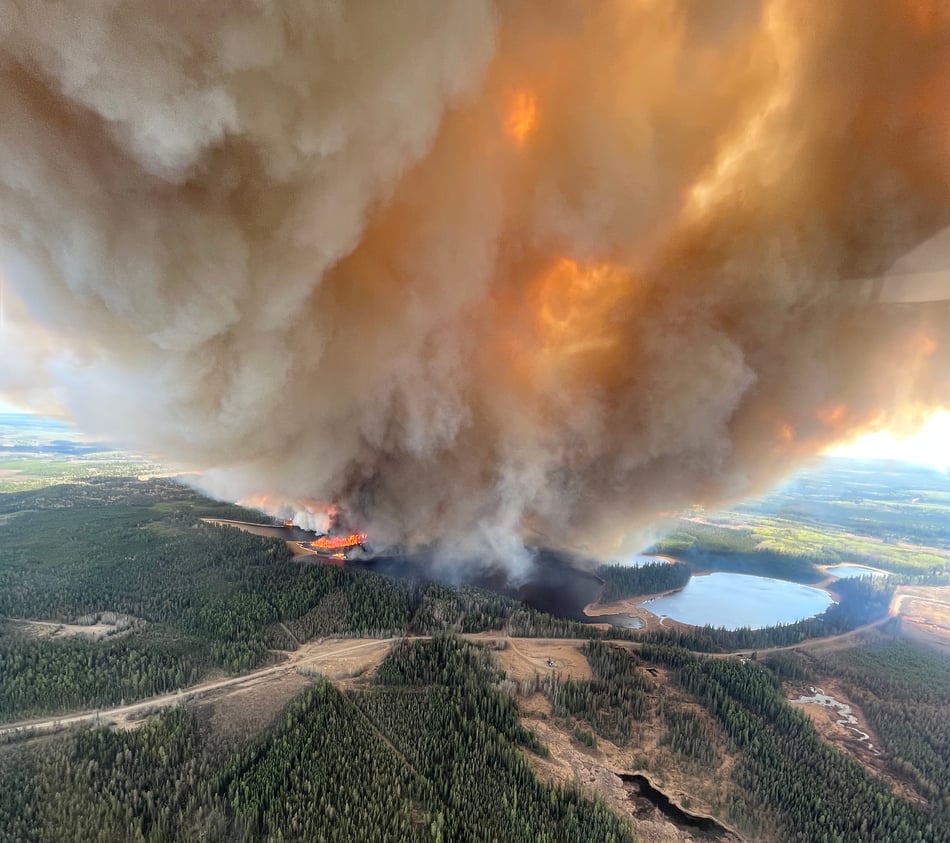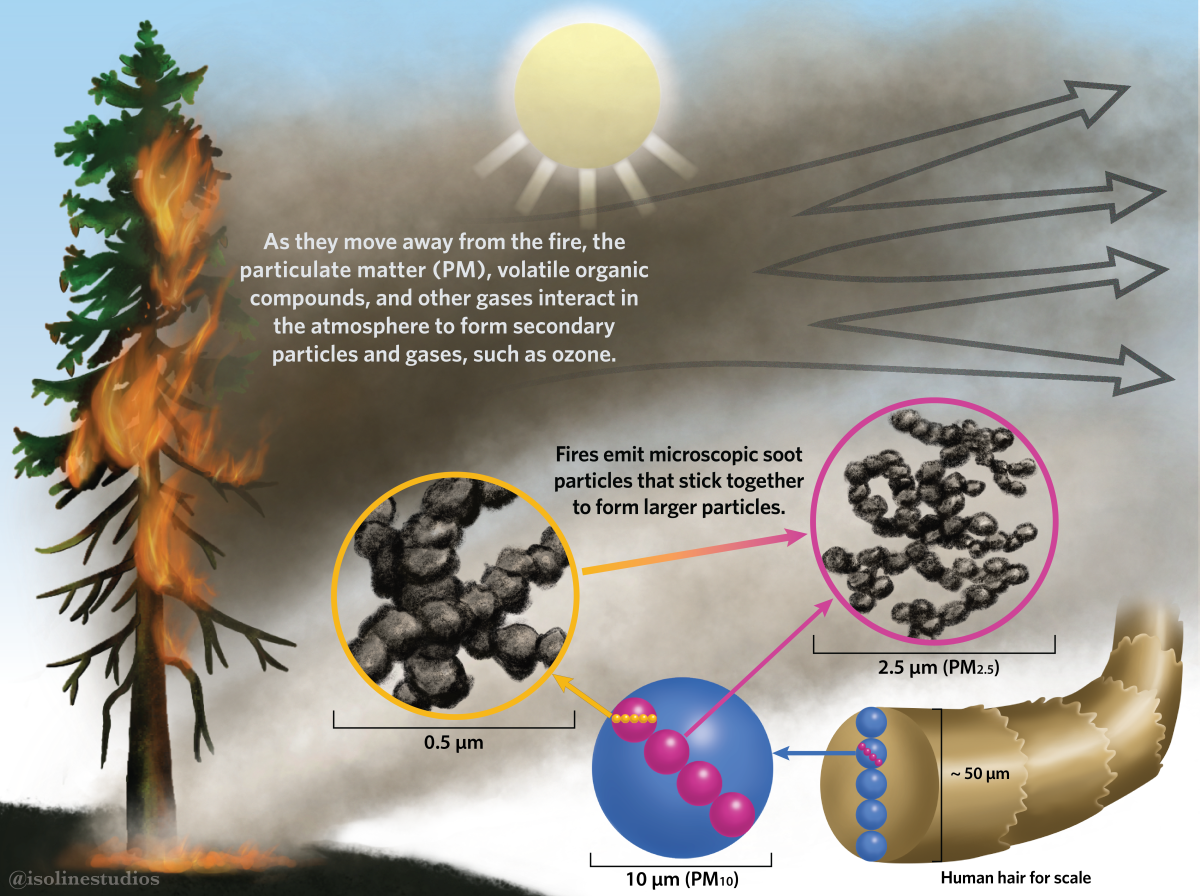As wildfires continue to burn in British Columbia and Alberta, the effects of the flames are being felt across Canada with thick plumes of smoke travelling thousands of kilometres, from the Northwest Territories to the east coast.

When a wildfire burns, it releases pollutants into the air, including sulphur dioxide, carbon monoxide, nitrogen oxides and volatile organic compounds, which can be hazardous to human health in the short and long term.

“It can travel miles and miles away from the actual fire,” explained Angela Yao, a senior scientist at B.C. Centre for Disease Control. “And when it reaches us, it can get pretty deep into our lungs and cause inflammation.”
Symptoms from wildfire smoke
Symptoms from wildfire smoke can vary, Yao said.
Mild symptoms may include irritated eyes, sore throat or headaches, while more severe symptoms such as wheezing, shortness of breath and chest pains are more likely to affect vulnerable groups such as young children, the elderly, pregnant women and those with preexisting conditions like asthma or diabetes.
Wildfire season in Canada is not only becoming longer due to a warming climate but also more intense, explained Mohit Bhutani, a lung specialist at the University of Alberta.
And as a result, there’s a lot more smoke and a lot more particulate matter that gets released into the air, he added.
“Every year, we’re seeing more and more patients in emergency rooms who are having symptoms due to the wildfires,” Bhutani said. We’re seeing patients who may not normally have had problems with their underlying lung and heart disease, have the aggravation of those conditions and require more urgent follow-up.”
As of Wednesday afternoon, there were 148 active fires across Canada; 43 were burning in British Columbia and 81 in Alberta.
The wildfires are raging so badly in Alberta, that the province is under a state of emergency with nearly 30,000 people forced to flee fires in the past week. Parts of the province, such as Edmonton, are also under a “moderate risk” for air quality health, according to Environment Canada.

Get weekly health news
The heavy smoke seen in B.C. and Alberta is not confined to that region – it can travel hundreds or thousands of kilometres from the fire zone.
Global News Chief Meteorologist Anthony Farnell said on Tuesday there was a ribbon of smoke extending from Alberta up over the Northwest Territories and Nunavut, connecting through the Great Lakes and all the way off the coast of Newfoundland.
“It’s been impacting southern Ontario, thick enough in spots to almost block out the sun,” Farnell said, adding that because the smoke is in the upper atmosphere, it is not impacting air quality in this region.
A threat to human health
Wildfire smoke is made up of a combination of gases and particles that undergo chemical reactions as they move away from the fire, according to the B.C. Centre for Disease Control.
The particles in wildfire smoke are tiny, but they tend to clump together when they travel. Fine particulate matter (PM2.5), one of the most concerning pollutants in wildfire smoke, poses the greatest threat to human health.
“Fine particulate matter is very small,” Yao said. “When they reach a person, they can get into your lungs and can either cause inflammation directly or can spill into the bloodstream and travel into the human circulation.”
Dr. Courtney Howard, an emergency physician in the Northwest Territories who is also a wildfire and health researcher, said although the literature is still evolving, researchers are finding that exposure to wildfire smoke is linked to an increased risk of respiratory infections, asthma, heart problems and chronic obstructive pulmonary disease (COPD) exacerbations.
For example, Howard, who lives and works in Yellowknife, published a study in 2021 in BMJ Open, and found that wildfires increased asthma and pneumonia-related emergency room visits, as well as COPD hospitalizations.
A 2021 study found that long-term exposure to wildfire smoke was associated with an increased risk of COPD hospitalizations. Another study published in 2020 said cardiac arrests increased with wildfire smoke exposure.

And according to a 2022 study published in The Lancet, long-term exposure to wildfires may increase the risk of lung cancer and brain tumors. This is because many of the pollutants emitted by wildfires are known human carcinogens, such as benzene, formaldehyde and heavy metals, according to the authors of the study.
Not only is there a physical impact, but wildfires also affect mental health, Howard said.
She said if people are forced inside because of thick smoke in the area due to wildfires, people may start feeling disconnected from the outdoors, their family and their community.
“This is an expression of eco-anxiety,” she said. “And we do know that we are going to see more smoky summers as the climate changes, it will statically get worse.”
How to protect your health
Canadians are likely to experience a “smoky summer” due to the early onset of the wildfire season, Howard said.
She said the first way to protect yourself from wildfire smoke — whether you may be in Alberta, Ontario, Newfoundland or in between — is to check the Health Canada Air Quality Health Index. If you type in your town or city name in the search function, you can see the level of air quality in the region.
The air quality health index ranges from low risk (around one to three on the scale) to high risk (around seven to ten on the scale).
If the air quality index is reading high risk, Howard said, people should refrain from any outdoor activity and stay inside if possible.

If the scale is moderate risk, Howard said people who have varying vulnerabilities, such as a preexisting respiratory condition, may want to modify their activity as there is some risk.
Another way to stay protected is to invest in a high-efficiency particulate air (HEPA) filter, she added.
“If you do need to go outside, it is recommended to put on an N95 or KN95 mask,” Howard said. “If you do have a well-fitting mask, it can filter out a majority of the smoke.
“Particularly if you’re somebody who is vulnerable, if you’re somebody who works outside and can’t reduce your hours in those circumstances, some good fitting masks can be really helpful.”
— with files from Global News’ Ryan Rocca and Saba Aziz











Comments